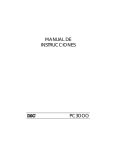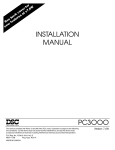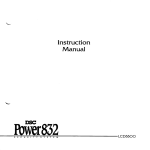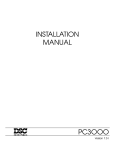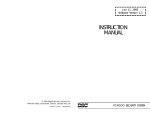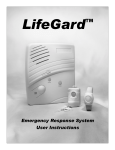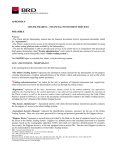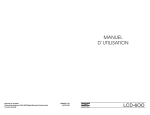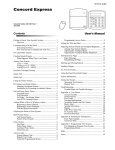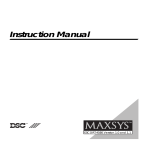Download Code Alarm 3000 Instruction manual
Transcript
System Reference Zone Area Type 1 ___________ _____________ 2 ___________ _____________ 3 ___________ _____________ 4 ___________ _____________ 5 ___________ _____________ 6 ___________ _____________ 7 ___________ _____________ 8 ___________ _____________ Fire Zone: ___________________________________________________________ Keypad Zones Keypad Zone [F] Fire _________________________________________________ Keypad Zone [A] Auxiliary _____________________________________________ Keypad Zone [P] Panic _______________________________________________ Access Codes Access Code Assigned To... 9 ___________ _____________ _____________ 10 ___________ _____________ _____________ 11 ___________ _____________ ___________ _____________ 12 ___________ _____________ 5 ___________ _____________ 13 ___________ _____________ 6 ___________ _____________ 14 ___________ _____________ ___________ _____________ ___________ _____________ Access Code Assigned To... 1 ___________ _____________ 2 ___________ 3 ___________ 4 7 ___________ _____________ 15 8 ___________ _____________ 16 Entrance and Exit Delays Entry Delay: Exit Delay: seconds seconds Auxiliary Entry Delay: Auxiliary Exit Delay: Monitoring Station Account Number: __________________________ Phone: ____________________________________ For Service Call: ______________________________________ Phone: ____________________________________ seconds seconds A Word About Your System The PC3000 Security System has been designed to give you the greatest possible flexibility and convenience. Read this manual carefully and become familiar with the operation of your Security System. Your installer will tell you which commands listed in this manual apply to your system. Fill out the System Reference sheet in this manual and store it in a safe place for future reference. The label provided for the inside of the keypad door can be used to record which sensors are on each zone. Important Note Remember that no security system can prevent emergencies. It is only intended to alert you in case of an emergency and should not take the place of prudent security practices or life and property insurance. It is important to test your system every week. To do this, first inform the monitoring station that you are testing your system. Then, with the system disarmed, activate all detection sensors one at a time and observe the zone light come on at the keypad as each sensor is activated. Perform a bell test by entering [ ],[6],[Master Code],[8] with the system disarmed. The PC3000 can be programmed at the time of installation to automatically perform a test transmission to the monitoring station on a regular basis. If the system has not been programmed for this automatic test, call the monitoring station for instructions on how to perform a test transmission. Don’t forget to inform the monitoring station when you have finished your test. * Check to see if the “Trouble” light is on when arming the system. See the Trouble Display section in this manual for a description of the different trouble conditions. Contact your installer for assistance if the trouble condition cannot be located and corrected. How Your System Works Your PC3000 Security System is made up of a control panel, one or more PC3000RK keypads, and various detectors and sensors. The control panel will be mounted out of the way in a utility room or basement. The metal cabinet contains the system electronics, fuses and stand-by battery. There is normally no reason for anyone but the installer to have access to the control panel. The keypad(s) have an audible indicator, display lights and command entry keys. The keypad is used to send commands to the system and to display the current system status. Keypads are mounted in convenient areas close to the exit-entry doors. The security system has up to eight zones or areas of protection. Each zone used will have connected to it various sensors, such as door or window contacts, motion detectors, glassbreak detectors and vibration or shock sensors. When a sensor is in alarm, a keypad light will be on to indicate which zone is in alarm. Master Code The 4 digit Master Code is used for arming and disarming the system, for programming additional access codes, and for changing other features. The Master Code will be supplied to you by your installer. All keypad entries are made by pressing one key at a time and may be changed by you at any time if the installer selects an option. For additional access codes, see Programming Additional Access Codes. Arming Close all protected doors and windows and stop movement in areas covered by motion detectors. If the “Bypass” light is ON, be sure zones are being intentionally bypassed before arming the system (see Zone Bypassing). Check to see that the “Ready” light is ON (all zones are closed). The system cannot be armed unless the “Ready” light is ON. Enter a [4 digit access code]. As each digit is entered, the keypad sounder will beep. Once the correct access code is entered, the “Armed” light will come ON and the keypad sounder will beep quickly. If the access code was entered incorrectly or the “Ready” light was not ON, the keypad sounder will beep steadily for 2 seconds. When the correct code is entered and the system is armed, exit through the door indicated by your installer as the exit-entry door. The exit time may be changed by your installer (please refer to the Quick-Arm feature). Auto-Bypass Option - Home-Away Arming This feature, if selected by your installer, will allow you to arm your system with any valid access code and the system will automatically bypass the interior zones if those interior zones have been designated as home-away zones by the installer. When activated, the “Bypass” light will come ON. If you exit within the allowed exit time, the system will automatically reactivate the interior zones. This feature is designed to save the user from having to manually bypass interior zones each time they wish to arm the system and remain at home. In residential applications where the system has been armed and the interior zones are automatically bypassed, the interior zones can be reactivated from a keypad outside the interior zones protection area (e.g. a bedroom). To reactivate the interior zones, press [ ] then [1] and the “Bypass” light will go out. * Entry Delay Off Arming If you wish to arm your system and eliminate the entry delay, enter [ ],[9] before your access code. The “Armed” light will flash as a reminder that the system is armed and has no entry delay. An entry through any zone programmed as a delay zone will create an instant alarm. * Disarming Enter the premises only through the door indicated by your installer as the entry door. The keypad sounder will be ON. Go to the keypad and enter the [4 digit access code]. If an error is made entering the code, press the [#] key and enter the code again. The “Armed” light will go out and the keypad sounder will stop. The correct access code must be entered before the allowed entry time expires. The entry delay time may be changed by the installer. If an alarm occurred while the panel was armed, the “Memory” light and the light for the zone which caused the alarm will start to flash and will continue flashing for 2 minutes. At the end of 2 minutes, the keypad lights will stop flashing and the keypad will return to the normal Ready condition. If you return home and find an alarm has occurred while you were away, it is possible that an intruder may still be on the premises. Go to a neighbour’s and if your system is monitored, call the monitoring station. They will advise what action has been taken as a result of the alarm and whether the premises are safe to enter. If your system is not monitored, call the local police to investigate. Alarm Memory Display If the “Memory” light is on, an alarm has occurred since the last time the panel was armed. The alarm memory will automatically be displayed when the system is disarmed (see Disarming). * Press the [ ] then [3] keys to display which zone caused the alarm. The alarm memory will be cleared when the panel is re-armed. Press [#] to return to Ready. Zone Bypassing Bypassed zones do not cause an alarm. Use zone bypassing when access is needed to part of the protected area. Also, damaged wiring or contacts on a zone may be temporarily bypassed until repairs can be made so that the panel can be armed. * To bypass zones, enter [ ],[1] and the zone numbers to be bypassed. i.e. [0][1] for zone 1, [1][6] for zone 16. If the [0] key is pressed twice instead of a zone number, all zone bypasses will be removed. If the [9] key is pressed twice, the last group of zones which was bypassed will be recalled. Press [#] to return to Ready. For security reasons, your installer may prevent the bypass command from operating on certain zones. The “Bypass” light is ON as long as at least one zone is bypassed. Do not unintentionally bypass zones when arming. Zone bypasses are automatically cancelled each time the panel is disarmed and must be re-applied before the next arming. Trouble Display The PC3000 continuously monitors a number of possible trouble conditions. If one of these conditions occurs, the keypad sounder will beep quickly twice every 10 seconds and the keypad “Trouble” indicator will light. Pressing any key on the keypad will silence the beeper but the “Trouble” light will remain on until the trouble condition is cleared. If you cannot determine the cause of the trouble condition, call your installer for assistance. Press the [ ] then [2] keys to display the type of trouble. The zone lights indicate the type of trouble condition. * Zone Light Trouble 1 Defective Stand-by Battery 2 AC Power Failure (see NOTE below) 3 Day Zone Trouble 4 Telephone Line Problem 5 Unsuccessful Communication Attempt with Monitoring Station 6 Bell Circuit Failure 7 Smoke Detector Circuit Trouble 8 Loss of Time on System Clock Press [#] to return to Ready. NOTE: The keypad buzzer will not sound for AC failure until there is also a low battery condition. The “Trouble” light will come ON as soon as AC fails and will remain on until AC restores. Smoke Detector and Fire Alarm Reset If your system is equipped with smoke detectors or other fire alarm detectors, use the following instructions for resetting an alarm. Before resetting a fire alarm signal, be sure you know the source of the alarm and that there is no danger (see Evacuation Planning elsewhere in this manual). The system bell/siren alarm signal pulses 2 seconds ON and 2 seconds OFF when the alarm is generated from the fire circuit. The transmission to the monitoring station is delayed by 30 seconds. The alarm may be silenced and the transmission delayed for 2 minutes by pressing any number key on the keypad. If the detector causing the alarm is reset before the 2 minute delay expires, no further alarm will occur. If the detector is not reset, at the end of the delay the alarm will start again and the transmission will occur in 30 seconds if a keypad key is not pressed. An immediate fire alarm signal and transmission is generated by holding down the [1] and [3] keys at the same time for 2 seconds. Some smoke detectors require entering a keypad command to reset them after an alarm. Press [ ] then hold down the [4] key for several seconds. If the smoke has cleared, the smoke detector will reset and the fire zone light will go out when the [4] key is released. If the smoke has not cleared from the detector, open a window or door and fan clean air into the detector and try resetting again. * Ready light ON: system is ready to be armed. Ready light OFF: open zone. Zone must be closed or bypassed before arming. Ready light flashing with “Armed” light ON indicates access code 9-16 programming. Bypass light comes ON when you bypass a zone. To bypass a zone, press [ ], [1], [Master Code] and then the zone(s) you wish to Bypass. Enter 01 for zone 1; 08 for zone 8; 16 for zone 16. Press [#] to return to ready. * Trouble light ON means there is a fault on the system. Press any key to silence keypad beeping. Press [ ] then [2] to display trouble type; one or more zone lights will come ON to indicate the type of trouble. When ON in the normal operating mode, the Zone Lights indicate an open zone. eg. open door, window, etc. Refer to zone chart on keypad door for zone information. Armed light will come ON indicating system is armed. Ensure “Ready” light is ON, enter [4 digit] access code. Armed light flashing with “Ready” light indicates access code 9-16 programming. Memory light ON means an alarm has occurred. To display zone that caused alarm, press [ ] then [3]. Zone light will come on indicating which zone caused the alarm. * * 1 2 3 4 5 6 7 8 Battery A.C. Power Day loop Telephone line Communicator Bell circuit Smoke detector circuit Clock needs resetting Fire light is ON when a detector on the fire loop is in alarm. Press any key within 30 seconds of first alarm to get 2 minutes to reset smoke detectors. Press [F] for 2 seconds to activate FIRE transmission. Press [A] for 2 seconds to activate an AUXILIARY transmission. Press [#]... ...when an error is made in entering code, then enter code again. ...to return to ready state after using [ ] commands. * Press [P] for 2 seconds to activate PANIC transmission. THESE BUTTONS WILL NOT FUNCTION UNLESS PROGRAMMED BY INSTALLER. Colored labels on keypad door indicate which keys are active. Programming Access Codes Up to 15 access codes in addition to the Master Code can be entered from the keypad. * Press [ ], [5] and [Master Code]. The “Program” light will flash and the zone lights will show which codes have already been programmed. To enter a new code or change an existing code, first press the code number [0][1] to [1][6] and then enter your [4 digit] code. To erase a code, press [ ] instead of a [4 digit] code. Note that the [ ] and [#] keys cannot be used in a code. **** * Press [#] to return to Ready. Quick-Arm Feature When the Quick-Arm feature is enabled, the panel may be armed simply by entering [ ], [0] instead of a 4 digit code. The [ ], [0] command will not disarm the panel. * * * Enter [ ], [6], [Master Code], [4] to turn ON and OFF the Quick-Arm feature. When the command is entered, the keypad will beep 3 times if the feature is being enabled and will sound one long beep if the feature is being disabled. Press [#] to return to Ready. Door Chime Feature The door chime feature is used, while the panel is disarmed, to provide a tone from the keypad each time a door or window is opened or closed. The doors and windows which will provide this indication are programmed by your installer. * Enter [ ], [6], [Master Code], [6] to turn the door chime feature ON and OFF. When the command is entered, the keypad will beep 3 times if the feature is being enabled and will sound one long beep if the feature is being disabled. Press [#] to return to Ready. Alarm Test Enter [ ], [6], [Master Code], [8] for a 2 second test of the keypad lights, keypad sounder and alarm bells. * Press [#] to return to Ready. Keypad Zones There are three zones which can be activated from the keypad. They are activated by pressing two keys at the same time and holding them for 2 seconds. These zones may or may not be active on your keypads depending on how your installer has programmed them. [F] Keypad FIRE zone. Pressing this key for 2 seconds will activate the keypad fire zone and the bell/siren output will pulse ON and OFF. This zone is annunciated by the “Fire” light on the keypad. [A] Keypad AUXILIARY zone. Pressing this key for 2 seconds will produce a series of beeps on the keypad along with the transmission. To confirm transmission, the keypad sounder will beep 6 times. [P] Keypad PANIC zone. Depending on how your installer programs the panel, pressing this key for 2 seconds may produce a completely silent alarm or an audible alarm along with the transmission. If programmed as audible, the alarm bell will ring. Testing It is recommended that the system be tested on a weekly basis. NOTE: Perform tests in the off-peak hours, such as early morning or late evening. 1 Inform the monitoring station that you are testing your system. 2 Disarm the system (“Ready” light should be ON). * 3 Perform a battery/bell test by pressing [ ], [6], [Master Code], [8]. The alarm will sound for about 2 seconds. If a trouble occurs after the test, press [ ], [2] to view the trouble condition. * 4 Activate each sensor in turn. For example, open a door or window. Observe the zone light come ON as each sensor is activated. The zone light will go OFF as each sensor is restored to normal (door or window is closed). 5 Press the [F] key. The signal will sound in a pulsed mode. Arm then disable the panel to silence the signal. Repeat this test by pressing the [A] and [P] keys in turn. Remember, the [A] key does not ring the bell and the [P] key may not be programmed for an audible signal. 6 If the fire zone is used, activation will cause the signal to sound in a pulsed mode. CAUTION: Do not use open flame or burning materials to test a smoke detector. Contact your installer for information on safe methods to activate a smoke detector. 7 Should your system fail to operate properly, call your installer for service. 8 When testing is complete, call and advise the monitoring station. Maintenance With normal use, the system requires minimum maintenance. The following should be observed: 1 Do not wash the keypad with a wet cloth. Light dusting with a barely damp cloth should remove normal accumulations of dust. 2 The battery/bell test is designed to determine battery condition, however it is recommended that the stand-by battery be replaced every three years. 3 For other system devices such as smoke detectors, passive infrared, ultrasonic or microwave motion detectors or glassbreak detectors, consult the respective manufacturer’s literature for testing and maintenance. Fire Safety in the Home Most fires occur in the home and to minimize this danger it is recommended that a household fire safety audit be conducted and a family escape plan be developed. Household Fire Safety Audit 1 Are all electrical appliances and outlets in a safe condition? Check for frayed cords, over-loaded lighting circuits, etc. If you are uncertain about the condition of your electrical appliances or household service, have a professional evaluation. 2 Are all flammable liquids stored safely in closed containers in a well ventilated cool area? Cleaning with flammable liquids should be avoided. 3 Are fire hazardous materials (such as matches) well out of reach of children? 4 Are furnaces and wood burning appliances properly installed, clean and in good working order? Have a professional evaluation. Family Escape Planning There is often very little time between the detection of a fire and the time it becomes deadly. It is thus very important that a family escape plan be developed and rehearsed. 1 Every family member should participate in developing the escape plan. 2 Study the possible escape routes from each location within the house and since many fires occur at night, special attention should be given to the escape routes from sleeping quarters. 3 It is essential that escape from a bedroom be possible without opening the interior door. Consider the following when making your escape plans: • Make sure that doors and windows that open to the outside are easily opened. Ensure that they are are not painted shut, and that their locks operate smoothly. • If opening the exit or using the exit is too difficult for children, the elderly or handicapped, plans for rescue should be developed. This includes making sure that those who are to perform the rescue can promptly hear the fire warning signal. • If the exit is above the ground level, an approved fire ladder or rope should be provided as well as training in its use. • Exits on the ground level should be kept clear. Be sure to remove snow from exterior patio doors in winter; outdoor furniture or equipment should not block exits. • The family should have a predetermined assembly point where everyone can be accounted for; for example, across the street or at a neighbour’s house. • Once everyone is out of the house, call the Fire Department. • A good plan emphasizes quick escape. Do not investigate first or attempt to fight the fire, and do not attempt to rescue belongings or pets as this takes up valuable time. Once outside, do not re-enter the house. Wait for the fire department. • Write the plan down and rehearse frequently, so that should an emergency arise, everyone will know what they are to do. Revise the plan as conditions change; for example, when there are more or fewer family members in the home, or if there are changes to the house. • Make sure your fire warning system is operational by conducting weekly tests as noted elsewhere in this manual. If you are unsure about system operation, contact your installing dealer. • It is recommended that you contact your local fire department and request further information on home fire safety and escape planning. If available, have your local fire prevention officer conduct an in-house fire safety inspection. Limited Warranty Digital Security Controls Ltd. warrants that for a period of twelve months from the date of purchase, the product shall be free from defects in materials and workmanship under normal use and that in fulfilment of any breech of such warranty, Digital Security Controls Ltd. shall, at its option, repair or replace the defective equipment upon return of the equipment to its repair depot. This warranty applies only to defects in parts and workmanship and not to damage incurred in shipping or handling, or damage due to causes beyond the control of Digital Security Controls Ltd., such as lightning, excessive voltage, mechanical shock, water damage, or damage arising out of abuse, alteration or improper application of the equipment. The foregoing warranty shall apply only to the original buyer, and is and shall be in lieu of any and all other warranties, whether expressed or implied and of all other obligations or liabilities on the part of Digital Security Controls Ltd. Digital Security Controls Ltd. neither assumes, nor authorizes any other person purporting to act on its behalf to modify or to change this warranty, nor to assume for it any other warranty or liability concerning this product. Warning Digital Security Controls Ltd. recommends that the entire system be completely tested on a regular basis. However, despite frequent testing, and due to but not limited to, criminal tampering or electrical disruption, it is possible for this product to fail to perform as expected. Printed in Canada © 1994 Digital Security Controls Ltd. 29000664 R1 October 7 1994 INSTRUCTION MANUAL PC3OOO WITH PC3OOORK KEYPAD Department of Communications Notice NOTICE: The Canadian Department of Communications label identifies certified equipment. This certification means that the equipment meets certain telecommunications network protective, operational and safety requirements. The Department does not guarantee the equipment will operate to the user's satisfaction. Before installing this equipment, users should ensure that it is permissible to be connected to the facilities of the local telecommunications company. The equipment must also be installed using an acceptable method of connection. In some cases, the company's inside wiring associated with a single line individual service may be extended by means of certified connector assembly (telephone extension cord). The customer should be aware that compliance with the above conditions may not prevent degradation of service in some situations. Repairs to certified equipment should be made by an authorized Canadian maintenance facility designated by the supplier. Any repairs or alterations made by the user to this equipment, or equipment malfunctions, may give the telecommunications company cause to request the user to disconnect the equipment. User should ensure for their own protection that the electrical ground connections of the power utility, telephone lines and internal metallic water pipe system, if present, are connected together. This precaution may be particularly important in rural areas. CAUTION: Users should not attempt to make such connections themselves, but should contact the appropriate electric inspection authority, or electrician, as appropriate. The Load Number (LN) assigned to each terminal device denotes the percentage of the total load to be connected to a telephone loop which is used by the device, to prevent overloading. The termination on a loop may consist of any combination of devices subject only to the requirement that the total of the Load Numbers of all the devices does not exceed 100. The Load Number of this unit is 42. AVIS: L’étiquette du ministère des Communications du Canada identifie le matériel homologué. Cette étiquette certifie que le matériel est conforme à certaines normes de protection, d’exploitation et de sécurité des réseaux de télécommunications. Le Ministère n’assure toutefois pas que le matériel fonctionnera à la satisfaction de l’utilisateur. Avant d’installer ce matériel, l’utilisateur doit s’assurer qu’il est permis de le raccorder aux installations de l’entreprise locale de télécommunication. Le matériel doit également être installé en suivant une méthode acceptée de raccordement. Dans certains cas, les fils intérieurs de l’entreprise utilisés pour un service individuel à ligne unique peuvent être prolongés au moyen d’un dispositif homologué de raccordement (cordon prolongateur téléphonique interne). L’abonné ne doit pas oublier qu’il est possible que la conformité aux conditions énoncées ci-dessus n’empèche pas la dégradation du service dans certaines situations. Actuellement, les entreprises de télécommunications ne permettent pas que l’on raccorde leur matériel à des jacks d’abonné, sauf dans les cas précis prévus par les tarrifs particuliers de ces entreprises. Les réparations de matériel homologué doivent être effectuées par un centre d’entretien canadien autorisé désigné par le fournisseur. La compagnie de télécommunications peut demander à l’utilisateur de débrancher un appareil à la suite de réparations ou de modifications effectuées par l’utilisateur ou à cause de mauvais fonctionnement. Pour sa propre protection, l’utilisateur doit s’assurer que tous les fils de mise à la terre de la source d’énergie électrique, des lignes téléphoniques et des canalisations d’eau métalliques, s’il y en a, sont raccordés ensemble. Cette précaution est particulièrement importante dans les régions rurales. AVERTISSEMENT: L’utilisateur ne doit pas tenter de faire ces raccordements lui-même; il doit avoir recours à un service d’inspection des installations électriques, ou à un électricien, selon le cas. L’indice de charge (IC) assigné à chaque dispositif terminal indique, pour éviter toute surcharge, le pourcentage de la charge totale qui peut être raccordée à un circuit téléphonique bouclé utilisé par ce dispositif. La terminaison du circuit bouclé peut être constituée de n’importe quelle combinaison de dispositifs, pourvu que la somme des indices de charge de l’ensemble des dispositifs ne dépasse pas 100. L’Indice de charge de ce produit est 42.














